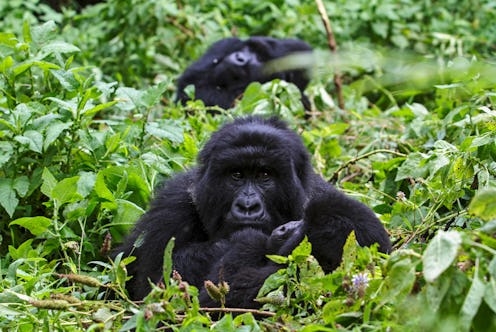News
Gorilla Experts Speak On Cincinnati Zoo Tragedy
On Saturday, handlers at the Cincinnati Zoo shot and killed Harambe, one of the gorillas living at the zoo, after a 4-year-old boy fell into the gorilla enclosure. Statements from zoo officials claim that the action was necessary, while critics maintain that alternative actions should have been taken. Gorilla experts are speaking out about Harambe's death, and their opinions are mixed.
Video footage and photos from onlookers show that the 450-pound silverback gorilla stood over the boy, then dragged him through the moat. CNN reported that Cincinnati Zoo Director Thane Maynard defended the use of a firearm instead of a tranquilizer dart in a statement:
Tranquilizers do not take effect for several minutes, and the child was in imminent danger. On top of that, the impact from the dart could agitate the animal and cause the situation to get much worse.
Jeff Corwin, an animal expert, echoed that reasoning. He told CNN, "depending on what the medication is, it can take upward to 10 to 15 minutes. It may take multiple shots." Mirror reported the comments of Sharon Redrobe, chief executive of Twycross Zoo:
The zoo keepers had a life and death situation on their hands and they would have known the behaviour of that animal better than anyone. The fact they left the situation for 10 minutes before firing the final shot shows they would have tried everything they could to get the male gorilla to enter the inside enclosure away from the boy.
But not all experts agree that shooting Harambe was necessary. According to The Daily Telegraph, Gisela Kaplan, animal behavior expert at the University of New England, questioned whether the boy was really in immediate danger:
The silverback would’ve understood that it was a defenceless small child. They would not normally attack, they are not an aggressive species (and) in the wild I’m certain the boy wouldn’t have been killed.
Kaplan noted that, though she questions the decision to use lethal force against Harambe, it's "hard to be too critical" because she was not on the scene as the incident occurred. Ian Redmond, chairman of The Gorilla Organization, said that there were other alternatives in addition to tranquilizing that the handlers could have tried:
When gorilla or other apes have things they shouldn't have, keepers will negotiate with them, bring food, their favorite treats, pineapple, or some kind of fruit that they don't know and negotiate with them. I don't know if that was tried or people thought there was too much danger but it does seem very unfortunate that a lethal shot was required.
Experts aren't on the same page regarding the level of danger the boy was in or whether the zoo's response team could have tried something else besides shooting the gorilla to keep the boy safe, and we have no way of knowing what would have happened if they did not act as they did, when they did. In a situation with such high stakes on both sides — the life of a child and the life of a gorilla — and with such varied opinions among animal experts, a clear conclusion is hard to come by.
As critics and officials continue to debate over whether the decision to resort to a rifle was appropriate, all parties join together in mourning the death of Harambe.
